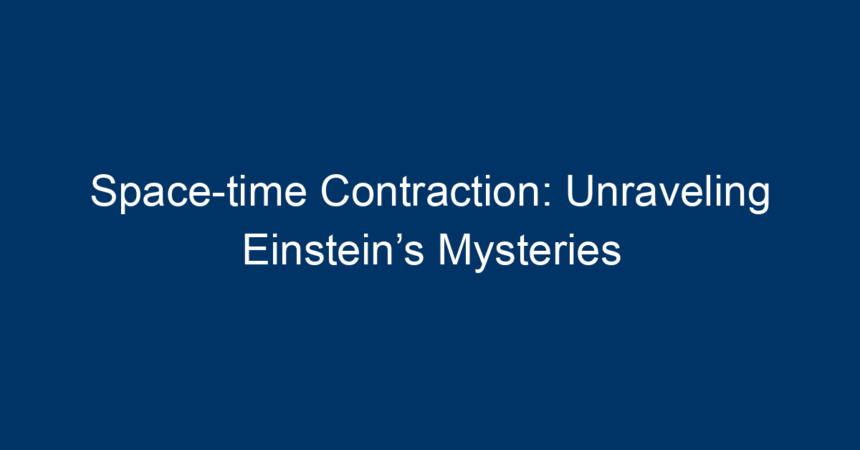Introduction
The concept of space-time contraction is one of the most mind-bending aspects of Einstein’s theory of relativity. This phenomenon challenges our understanding of the universe, altering our perception of reality itself. But what exactly is space-time contraction? How does it impact our world and the very fabric of space and time? In this article, we will delve into the intricacies of space-time contraction, broken down into understandable sections to unravel one of Einstein’s most mysterious legacies.
What is Space-Time Contraction?
Space-time contraction refers to the phenomenon where objects appear to shorten in the direction of motion as they approach the speed of light. This concept arises directly from Einstein’s theory of special relativity, which revolutionized physics in the early 20th century. Though it sounds abstract, space-time contraction has profound implications for our understanding of the universe.
When an object travels at relativistic speeds—close to the speed of light—it experiences a contraction in time and space. This means that time appears to pass more slowly for the moving object compared to a stationary observer. This leads us to another vital term: time dilation, which accompanies space-time contraction and highlights the interconnectedness of time and space in the relativistic framework.
The Origins of Space-Time Contraction
Einstein’s Theory of Special Relativity
Einstein first published his groundbreaking ideas in 1905. At its core, the theory posits two fundamental postulates:
- The laws of physics are the same for all observers, regardless of their relative motion.
- The speed of light in a vacuum is constant and will always be measured as approximately 299,792,458 meters per second, irrespective of the observer’s motion.
From these postulates, Einstein derived the equations that predict space-time contraction. The mathematical formulation involves Lorentz transformations that explain how time and space are intertwined.
The Lorentz Transformation
Whereas Newtonian physics treats time and space as separate entities, the Lorentz transformation reveals their interdependence. For an object moving at a velocity (v), governed by the equation:
[
L = L_0 \sqrt{1 – \frac{v^2}{c^2}}
]
Here, (L) is the contracted length, (L_0) is the proper length (the length measured in the object’s rest frame), (v) is the object’s velocity, and (c) is the speed of light. As (v) approaches (c), the term under the square root diminishes, leading to significant contraction.
Real-World Examples of Space-Time Contraction
Particle Accelerators
One of the most compelling demonstrations of space-time contraction can be found in particle accelerators. When protons are accelerated to speeds close to that of light in machines like the Large Hadron Collider, they exhibit a measurable contraction of length. This is not mere theory; scientists observe these effects directly through experimental data.
The Twin Paradox
Another illustrative example is the famous Twin Paradox, a thought experiment involving two twins: one stays on Earth, while the other travels in a spacecraft at near-light speeds. When the traveling twin returns, they will be younger than their Earth-bound sibling due to the combined effects of time dilation and space-time contraction.
Space-Time Contraction and GPS Technology
The implications of space-time contraction extend beyond theoretical physics. Global Positioning System (GPS) technology relies on accurate time measurements to provide precise location data. However, the satellites orbiting Earth encounter effects described by both space-time contraction and time dilation due to their high speeds and the weaker gravitational field compared to the surface of the Earth.
The result? GPS systems are corrected for these relativistic effects, ensuring that users receive accurate positioning data. Thus, our everyday technologies are reliant upon the very principles that Einstein elucidated over a century ago.
The Impact on Theoretical Physics
Black Holes and Space-Time
Einstein’s theories set the stage for exploring extreme gravitational fields, such as those surrounding black holes. As matter collapses into a singularity, the rules of space-time break down, leading to what might be considered infinite space-time contraction. These regions challenge our understanding of physics and remain one of the most captivating areas of research.
Quantum Mechanics and Space-Time
Additionally, as physicists delve deeper into the realm of quantum mechanics, space-time contraction raises questions about the very nature of reality. What happens to space and time at quantum scales? This question remains unresolved and is crucial for the development of a unified theory that bridges the gap between relativity and quantum mechanics.
Addressing Common Misconceptions
Is Space-Time Contraction a Perspective Illusion?
A common misconception is that space-time contraction is merely an illusion, a byproduct of perspective. However, extensive experimental evidence backs up this theory. When viewed from appropriate frames of reference, measurements of contraction are verifiable, not merely subjective.
Can We Experience Space-Time Contraction?
While we currently do not possess the technology for human travel at relativistic speeds, the principles of space-time contraction still apply in theory. Understanding these effects lays the groundwork for discussions around future space exploration and potential human interactions with relativistic speeds.
Actionable Insights: Connecting Minds and Concepts
-
Explore Further: Engage with scientific literature or online courses that discuss Einstein’s theories. Websites like Coursera or edX offer excellent resources for delving deeper into physics.
-
Experiment with Simulations: Online physics simulators allow users to visualize the effects of space-time contraction. Tools like PhET provide interactive ways to grasp complex concepts.
- Stay Curious: Follow modern scientific developments related to relativity and quantum physics. Books, webinars, and documentaries can keep you informed about new discoveries.
Conclusion
Space-time contraction reveals the fascinating complexity of our universe. By understanding this phenomenon, we not only grow our comprehension of Einstein’s revolutionary theories but also appreciate their practical applications in technology and our daily lives. As we continue to explore and unravel the mysteries of space and time, we bridge the gap between the observable universe and the theoretical constructs that describe it. Engaging with these concepts not only broadens our perspective but also inspires future generations to uncover deeper mysteries of the cosmos.




